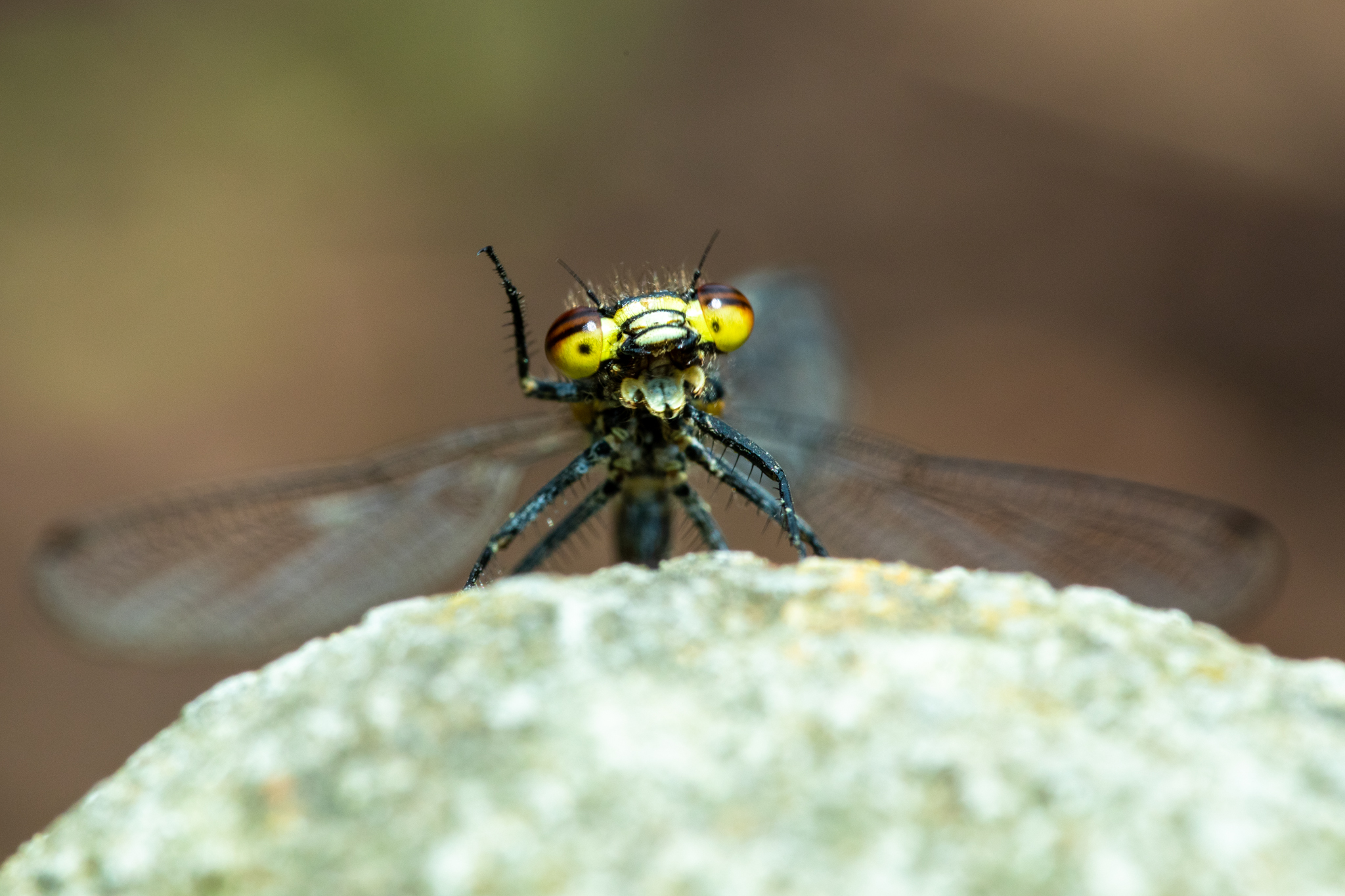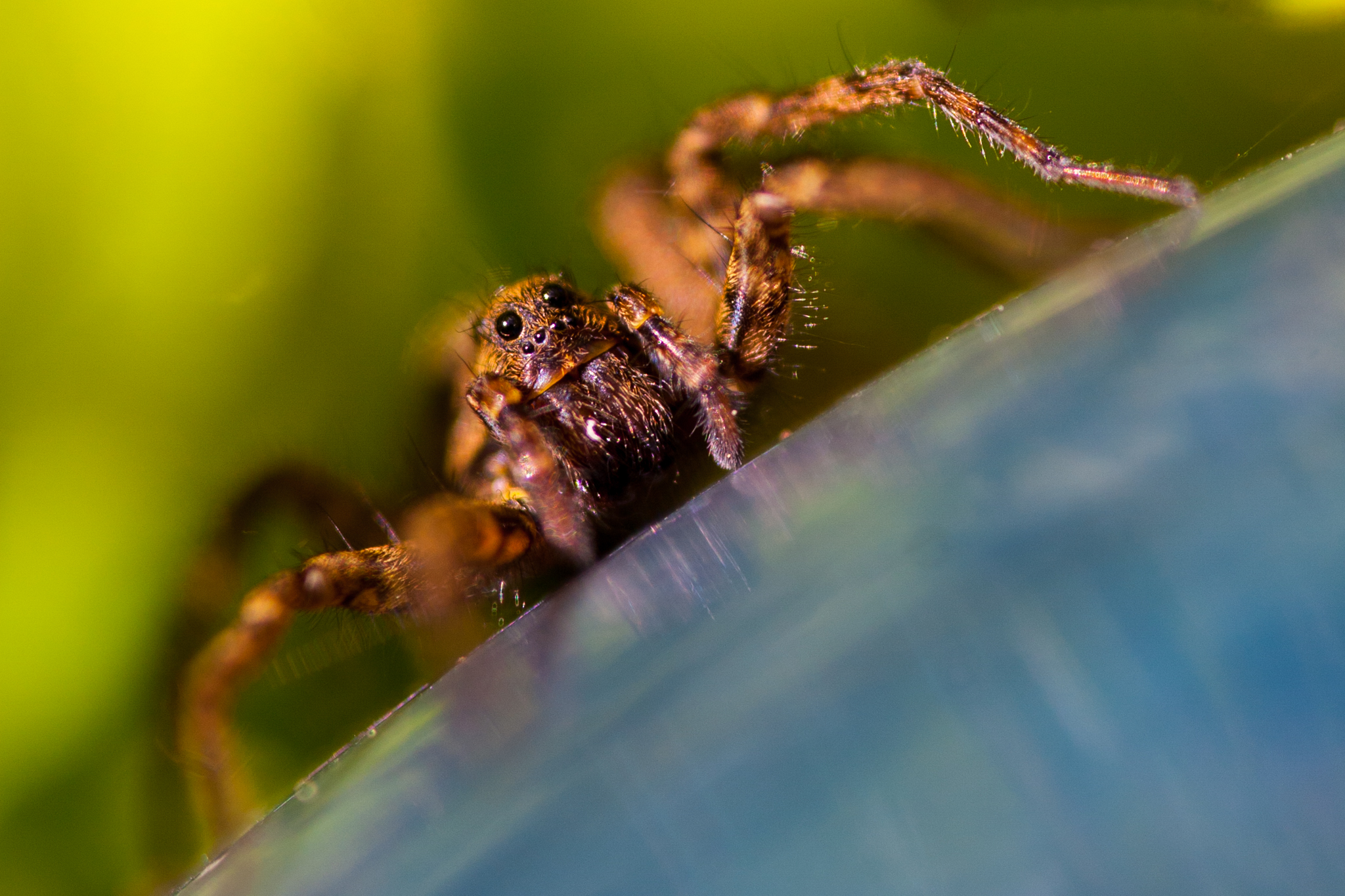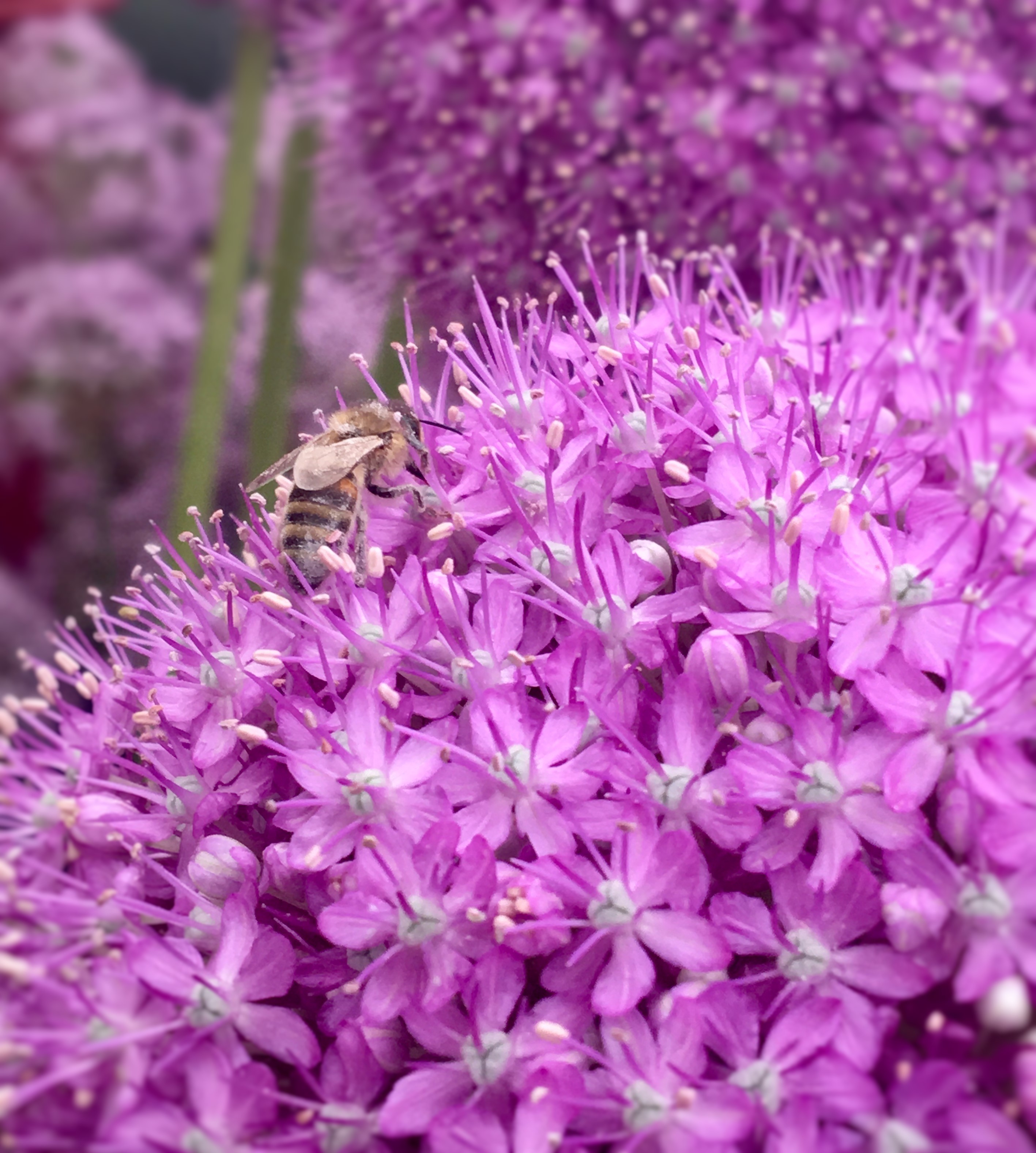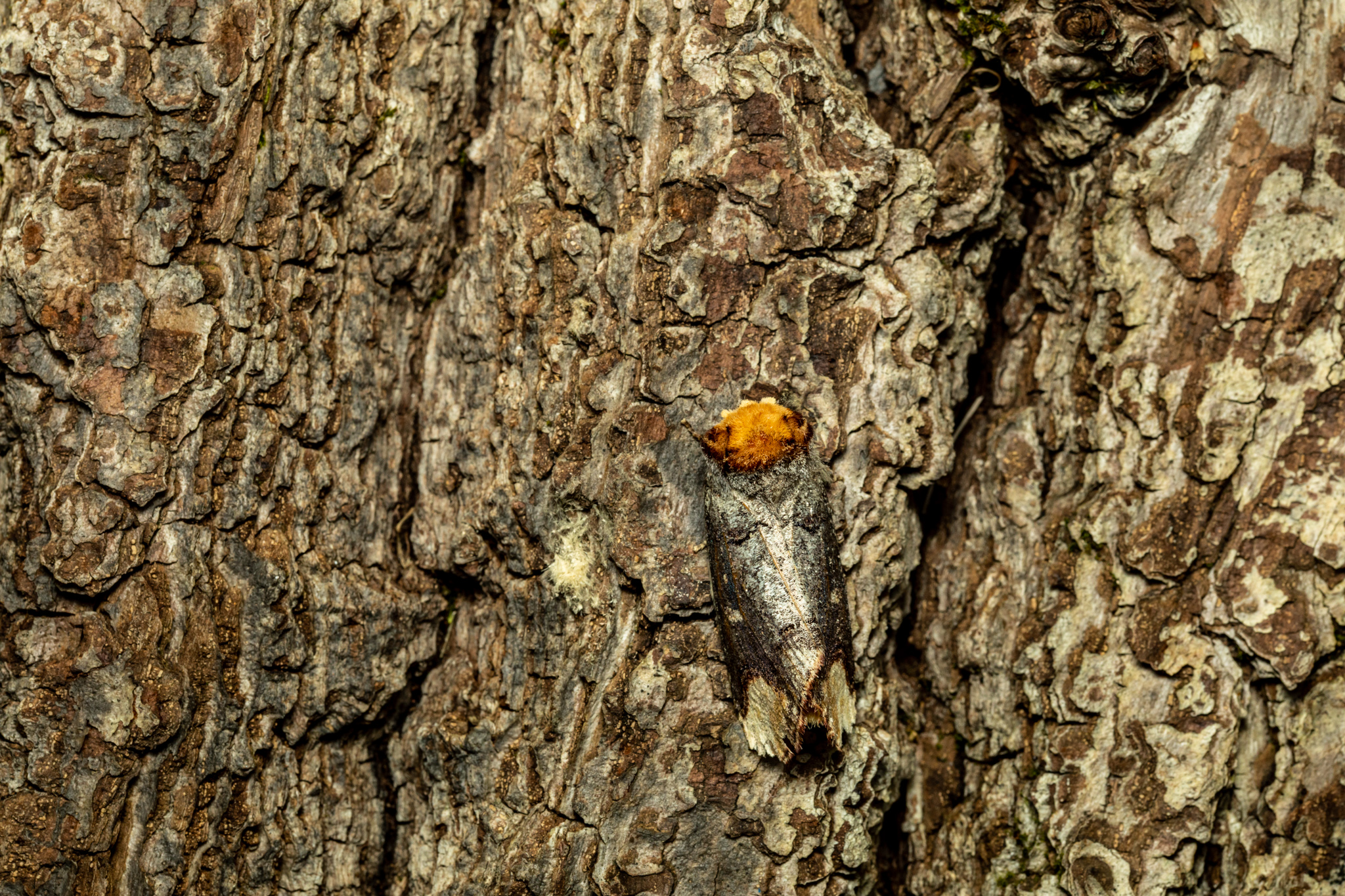"It never occurred to me to be anything other than fascinated when watching what was going on in the natural world about me."
—David Attenborough
Behold the insect!
Its beauty and horribleness. Its mullioned thorax and prehensile leg joints. Its rapacious strength and six-dimensional speed. Its ocular multiplex and hive mentality.
 Photograph by Ellen Vrana.
Photograph by Ellen Vrana.Okakura Kakuzo, a Japanese scholar who wrote a thoughtful monograph on the life-improving qualities of tea, begged that we pay attention to the small lest we ignore the large in ourselves. Indeed, insects are tiny beings. Sentient beings, perhaps we see a cosmic echo of ourselves in their existence.
They are sentient but not too sentient. They have eyes, legs, arms, scant nervous systems, and an enviable talent for species survival. There is also something I admire about their work ethic. Have you ever seen an ant stop moving? Or a bee?
A cluster of ladybugs is called loveliness.
Insects are demonstrably other, not human in any way. And yet, we can have empathy for them, even kinship.
 A common red damselfly by nature photographer and conservationist Joshua Burch.
A common red damselfly by nature photographer and conservationist Joshua Burch.“When I was 11 years old,” David Attenborough reminisced in his enchanting memoirs, “It wasn’t unusual for a boy of my age to get on a bicycle, ride off into the countryside and spend a day away from home. … Just turning over a stone and looking at the animals beneath is exploring. It never occurred to me to be anything other than fascinated.”
You are never more than five feet from a spider.
I’m not advocating we all notice insects constantly or be fascinated immediately, but rather that we awaken and nurture the part of us that wants to pay attention to insects. Our child self that repositions rocks to find hidden creatures and unknown industries.
Scientifically, naturalistically, creatively, and compassionately, we should reach across that which divides us and pay attention to insects.
The knowledge acquired in lifespans is measured in eaten leaves and summited grass blades: their variation, volume, and sheer utility. The collective mind is the non-language language.
To encourage your wonder, I’ve gathered a few glorious examples. Enjoy!

Henry David Thoreau and the Ants
“We must learn to reawaken and keep ourselves awake,” wrote one of the world’s greatest nature writers while repining by himself in a pond west of Boston. Thoreau partook of the large and the small and wove his nature writings from that engagement. “Not by mechanical aids, but by an infinite expectation of the dawn.”
Thoreau continues:
One day when I went out to my wood pile, or rather my pile of stumps, I observed two large ants, the one red, the other much larger, nearly half an inch long, and black, fiercely contending with one another. Having once got hold they never let go, but struggled and wrestled and rolled on the chips incessantly. Looking farther, I was surprised to find that the chips were covered with such combatants, that it was not a duellum, but a bellum, a war between two races of ants, the red always pitted against the black, and frequently two red ones to one black.
The legions of these Myrmidons covered all the hills and vales in my wood-yard, and the ground was already strewn with the dead and dying, both red and black. It was the only battle which I have ever witnessed, the only battle-field I ever trod while the battle was raging; internecine war; the red republicans on the one hand, and the black imperialists on the other. On every side they were engaged in deadly combat, yet without any noise that I could hear, and human soldiers never fought so resolutely. I watched a couple that were fast locked in each other’s embraces, in a little sunny valley amid the chips, now at noon-day prepared to fight till the sun went down, or life went out.
From Henry David Thoreau’s Walden
Gerald Durrell and the Lacewing Flies
Has anyone noticed insects more delightfully than Durrell? As a child growing up (gloriously under-parented) on the island of Corfu, Durrell nurtured a mind devoted to seeing nature and saying Pay attention! And he left the rest of us with multiple books about his adventures and animal pals.
I found a lacewing-fly on the roses and watched her as she climbed about the leaves, admiring her beautiful, fragile wings like green glass, and her enormous liquid golden eyes. Presently she stopped on the surface of a rose-leaf and lowered the tip of her abdomen. She remained like that for a moment and then raised her tail, and from it, to my astonishment, rose a slender thread, like a pale hair. Then, on the very tip of this stalk, appeared egg. The female had a rest, and then repeated the performance until the surface of the rose-leaf looked as though it was covered with a forest of tiny club moss. The female rippled her antennae briefly while laying over and flew off in a mist of green gauze wings.
From Gerald Durrell’s My Family and Other Animals
Emma Mitchell and the Ladybug
Like others who have traipsed about to find stillness within, British writer and nature collector Emma Mitchell believes in movement, there is a blessing. But not just movement – abandonment of the dark, thudding muck that had been her emotional headspace during chronic depression. Mitchell's annual diary, written from these depths seeking heights, has many close observations, but one caught my eye specifically:
The sun has opened their petal-like scales, forming shapes like miniature dried sunflowers. As I examine them there’s small glimmer of red in my vision and at first I mistake it for a retinal flash caused by bending down too quickly, but it persists and looking more closely I realize that there are ladybirds in the centre of many of the rosettes. In one of them five are nestled, motionless and in the torpor of hibernation. The centres of the seed heads are hairy, trapping air and forming a layer of insulation, preventing frost from penetrating and providing protection for the ladybirds when the temperature drops on clear nights. There is a reason that ladybirds gather together in groups to overwinter. If a ladybird is attacked by a bird or other predator on a day when it is active it will produce a yellowish fluid from its leg joints called, rather gothically, ‘reflex blood’. It is rich in alkaloids and is bitter and foul tasting to birds. Along with its bright coloration, this response is an effective deterrent, and after attempting to eat their first ladybird and receiving a beak full of acrid toxins most birds will avoid them.
The seasonality of weather also affects ladybugs (as I'm sure you imagined it would):
During winter when their usual aphid or scale-insect food is not available and temperatures drop too low to permit activity, ladybirds must hibernate in order to survive. The production of reflex blood costs energy that the ladybirds do not have to spare, so they no longer produce it in response to an attack between November and March. Instead, the ladybirds huddle together in a place where frost cannot reach them: between the needles of yew, in the curled-up desiccated leaves of beech or in the crook of a branch of wild rose. Should a robin or dunnock decide to chance a wintry ladybird snack, one of the group may be lost but the rest will remain, huddled together and looking at first glance like a rather large insect sporting the warning colours of red and black.
From Emma Mitchell’s The Wild Remedy: How Nature Mends Us
 A wolf spider by photographer Joshua Burch.
A wolf spider by photographer Joshua Burch.Charles Darwin and the Beetle
In 1831 Charles Darwin was an amateur naturalist and an aspiring preacher when he was invited to accompany the HMS Beagle as the onboard naturalist. The trip lasted five years, and his notes were later published as The Voyage of the Beagle.
Darwin’s extremely detailed observations set the basis for his theory of evolution by natural selection, published much later in The Origin of Species in 1859. I love how he retains a perfect scientist vibe even though he is excited by what’s unfolding.
When we were at Bahia, an elater or beetle (Pyrophorus luminous) seemed the most common luminous insect. The light in this case was also rendered more brilliant by irritation. I amused myself one by observing the springing powers of this insect, which have not, as it appears to me, been properly described. When placed on its back and preparing to spring, the elater moved its head and thorax backwards so that the pectoral spine was drawn out and rested on the edge of its sheath. The same backward movement being continued, the spine, by the full action of the muscles, was bent like a spring; and the insect at this moment rested on the extremity of its head and wing-cases. The effort being suddenly relaxed, the head and thorax flew up, and in consequence, the base of the wing-cases struck the supporting surface with such force, that the insect by the reaction was jerked upwards to the height of one or two inches. The projecting points of the thorax, and the sheath of the spine, served to steady the whole body during the spring. In the descriptions which I have read, sufficient stress does not appear to have been laid on the elasticity of the spine: so sudden a spring could not be the result of simple muscular contraction, without the aid of some mechanical contrivance.
From Charles Darwin’s The Voyage of the Beagle
Annie Dillard and the Praying Mantis
Annie Dillard’s unparalleled “noticing of nature” is worth so much time. We’ll settle for this slice of her Pulitzer Prize-winning writing, a spell-binding observation of nature and self at the most immediate, conscious level.
I have just learned to see praying mantis egg cases. Suddenly I see them everywhere; a tan oval of light catches my eye, or I notice a blob of thickness in a patch of slender weeds. As I write I can see the one I tied to the mock orange hedge outside my study window. It is over an inch long and shaped like a bell, or like the northern hemisphere of an egg cut through its equator. The full length of one of its long sides is affixed to a twig; the side that catches the light is perfectly flat. It has a dead straw, dead weed color, and a curious brittle texture, hard as varnish, but pitted minutely, like frozen foam. I carried it home this afternoon, holding it carefully by the twig and several others—they were light as air. I dropped one without missing it until I got home and made a count.
Within the week I’ve seen thirty or so of these egg cases in a rose-grown field on Tinker Mountain, and another thirty in weeds along Carvin’s Creek. One was on a twig of tiny dog-wood on the mud lawn of a newly built house. I think the mail-order houses sell them to gardeners at a dollar apiece. It beats praying, because each case contains between one hundred twenty-five to three hundred fifty eggs. If the eggs survive ants, woodpeckers, and mice—and most do—then you get the fun of seeing the new mantises hatch, and the smug feeling of knowing, all summer long, that they’re out there in your garden devouring gruesome numbers of fellow insects all nice and organically. When a mantis has crunched up the last shred of its victim, it cleans its smooth green face like a cat.
From Annie Dillard’s The Pilgrim at Tinker Creek
 Bee pollinating the allium. Photograph by Ellen Vrana.
Bee pollinating the allium. Photograph by Ellen Vrana.Grace Paley and the Bee
Poet Grace Paley said a beautiful thing once; she avoided nature because it reminded her of mortality. Except she didn’t avoid nature entirely because she noticed the bee. May we all have such courage.
A bee
drowning in
a wild rose
flat on its
round back
kicking
too young to
use love for
health and
entertainment
From Grace Paley Begin Again, Collected Poems
When we observe insects – or rather when we nurture the part of us that longs to observe insects – one must understand they are not happening to us.
They are and we are, coincidentally.
Ant species have more 16% more biomass than human species.
They reflect something hidden in us, a collective mind, perhaps. A vulnerability to something more significant that could destroy all of us instantly.
 Buff tip of a camouflaged moth. Photograph by Joshua Burch.
Buff tip of a camouflaged moth. Photograph by Joshua Burch.Imagine an insect. Now imagine that insect on its back in the water struggling to right itself.
Did your feelings shift? Even a bit?
A group of cockroaches is called an intrusion.
What if I told you it was a bee? A spider? A ladybug?
Get lost in the insect and his doings. If your emotions shift, bad or good, you are tapping into your umwelten, an ability to think what the animal is thinking. That suspension of self is the height of empathy. Insects are something else. This utterly different creature.
It is an insect. Pay attention!

